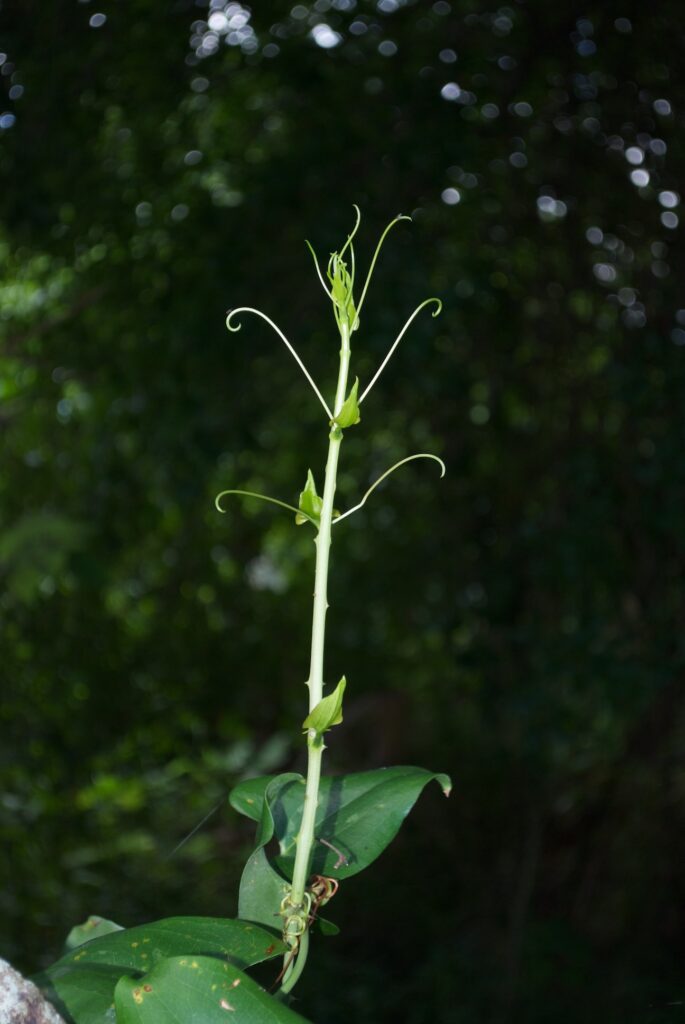
Smilax is a “climbing shrub” not a vine. Photo by Green Deane.
We’ve slipped into Smilax season. It’s easy to collect a handful of them now. This past week we saw them in warm Port Charlotte and in chilly Melbourne. More to the point young shoots are at their best this time of year. When we turn permanently warm (summer) the shoots tend to be bitter and peppery, which goes away with cooking. Now is raw smilax time.
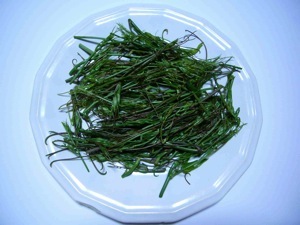
Smilax is considered by many the best springtime green. Photo by Green Deane
In Europe, where there is less resistance to eating wild food, we have the nutritional content of S.aspera leaves and shoots. A hundred grams of them have 100 calories, 3.5 grams of protein, 0.95 grams of fat, 9.92 grams of carbohydrates, and 18.8 grams of fiber. Vitamin E is particularly high, 29.1 mg which is nearly 200% of your daily need. It also has 4.5 mg of beta-tocopherol. The mineral line up is: Calcium 353 mg, potassium 180 mg, magnesium 61.2 mg, zinc 213 mg, iron 1.66 mg, and manganese 0.551 mg. Several species tested negative for vitamin C. While we don’t often eat the berries they are edible when they look like raisins (of if you dehydrate plump black ones into raisins-like fruit.) Per 100 grams the fruit of S. herbacea have 8.3 grams of protein, 4 grams of fat and 6.4 grams of fiber.
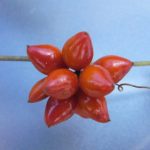
The red berries of Smilax walteri. Photo by Green Deane
To my knowledge all smilax tips, berries and roots are edible. I eat the ripe berries of all the local species except one, S. walteri. I avoid S. walteri berries because they are red. I avoid them out of an abundance of caution, not on any evidence. There is a red-berried Smilax on Crete whose berries are eaten. Expert comments on respected sites say no smilax is toxic. My thinking is S. Walteri has red berries for some reason (which could be to attract specific seed eaters.) There are about 300 or more species in the genus Smilax and are found in the Eastern half of the United States and Canada, basically east of the Rockies. Fourteen species are found in the southern United States. It should be mentioned that early American settlers made a real root beer from the smilax. They would mix root pulp with molasses and parched corn then allowed it to ferment. One variation is to add sassafras root chips, which gives it more of the soft drink root beer flavor. Dr. Francis Porcher wrote during the Civil War in the 1860’s “The root is mixed with molasses and water in an open tub, a few seeds of parched corn or rice are added, and after a slight fermentation it is seasoned with sassafras.”
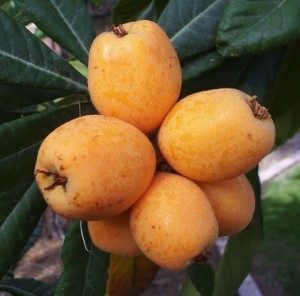
Loquats actually have a small amount of arsenic in them. Photo by Green Deane
While driving around have you seen a tree with large, dark green leaves and yellow fruit? It’s probably a Loquat which ripening fruit now. This past Week I picked 10 pounds of Loquats in less than an hour. That’s calorie positive. Rather than eating them outright I deseeded then dehydrated them. As plums change to prunes the dried Loquate change character but it is still tasty. I have also learned over the years that adding sulfur before drying does not stop the fruit from browning. You can dehydrate tart and sweet Loquats but you should avoid all green Loquats. Unripe fruit can be toxic especially for children. As long as the fruit is yellow to gold they are good. If you can detect any green hues the fruit is not ripe.
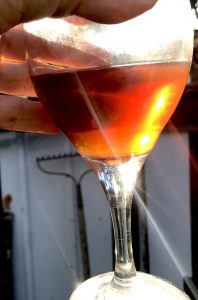
Two -year-old loquat wine. Photo by Green Deane
Loquats are not native but they have naturalized themselves and can be found throughout the region. How you eat the ripe fruit is something of a debate. I just break off the stem that holds them to the tree then eat, spitting out the seeds. You should try to not eat any seeds. An occasional seed is of no great harm but they generally are not considered edible though I have heard of folks roasting them then eating them. I do not recommend that. Some people also peel the fruit but I don’t. To dry them all I do is cut around the equator of a each fruit, take out the seeds (used later to make into Loquat Grappa.) Then dehydrate the fruit at about 130 F. I also made loquat wine two years ago during COVID. It tastes similar to a dry semi-sweet sherry. You can read more about Loquats here.

My step-father, me and our dog “sister” 1958. Photo by Mae Lydia Putney
My step-father built the house we lived in and the horse and hay barns next door. As the building season is short in Maine this took several years. Thus the front yard was totally ignored until my mother demanded one spring that something intentional grow there. She had grass in mind. So my step-father took several wheelbarrows of chaff from the bottom of the hay barn and spread it on what would be the lawn. Within a few weeks it grew a huge crop of Wild Mustard. The second flush was Lamb’s Quarters, also called Fat Hen.
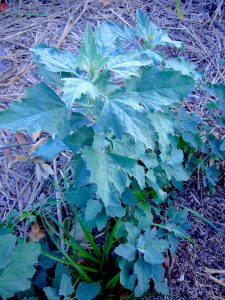
Which of a dozen Pig Weeds is it? Lambs quarters. Photo by Green Deane
One day not long after that a neighbor was visiting, a chicken farmer named William Gowen. As he left to walk home he ask my father if he could have a few Lamb’s Quarters. My step-father said he could. Mr. Gowen pulled up about eight five-foot high plants, hefted them over a shoulder, and happily carried them home to eat. Until then I had no idea they were edible. As Mr. Gowen was also a good gardener I am sure any Lamb’s Quarter that dared to grow in his garden also became dinner. I was reminded of him while on the way to my foraging class Sunday. Along the way I saw a lot of Lambs Quarters in several citrus groves. The name Lamb’s Quarters has nothing to do with lambs. It was a leafy green eaten some 1300 years ago on Lammas Quarter day (August 1st) in England (some say Scotland.) Lammas came from Loaf Mass, as the day was of religious significance. A loaf from newly harvested grain was made and taken to church and blessed. It is called Fat Hen because it supposedly was good to fatten hens. “Pigweed” is a common name for many different plants.

Foraging classes are held rain or shine, heat or cold. Photo by Nermina Krenata
Foraging Classes: No horrible weather in the forecast for the next two weeks.
Saturday, February 24th, Mead Garden: 1500 S. Denning Dr., Winter Park, FL 32789. 9 a.m. to noon. Meet at the bathrooms.
Sunday, February 25th, Eagle Park Lake, 1800 Keene Road, Largo, FL 33771. Meet at the pavilion near the dog park. 9 a.m. to noon.
Saturday, March 2nd, George LeStrange Preserve, 4911 Ralls Road, Fort Pierce, FL, 34981, 9 a.m. to noon
Sunday, March 3rd, Red Bug Slough 5200 S. Beneva Road, Sarasota. 9 a.m. to noon. Construction is over at the park. Meet at the main entrance on Beneva.
To read more about the classes, to pre-pay or sign up, go here.

You get the USB, not the key.
172-video USB would be a good end of spring present and is now $99. My nine-DVD set of 135 videos has been phased out. The USB videos are the same videos I have on You Tube. Some people like to have their own copy. Most of the 172 USB videos have to be copied to your computer to play. If you want to order the USB go to the DVD/USB order button on the top right of this page. That will take you to an order form.

Green Deane Forum
Want to identify a plant? Perhaps you’re looking for a foraging reference? You might have a UFO, an Unidentified Flowering Object, you want identified. On the Green Deane Forum we — including Green Deane and others from around the world — chat about foraging all year. And it’s not just about warm-weather plants or just North American flora. Many nations share common weeds so there’s a lot to talk. There’s also more than weeds. The reference section has information for foraging around the world. There are also articles on food preservation, and forgotten skills from making bows to fermenting food.
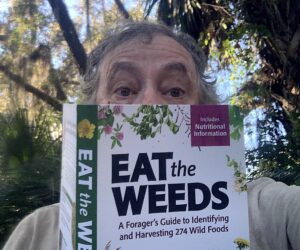
Finally, a physical copy of the book.
Now in print is EatTheWeeds, the book. It has 275 plants, 367 pages, index, nutrition charts and color photos. It’s available in many locations including Amazon. Most of the entries include a nutritional profile. It can also be ordered through AdventureKeen Publishing. To date it has sold about 8,000 copies.
This is weekly newsletter #589. If you want to subscribe to this free newsletter you can find the sign-up form in the menu at the top of the page.
To donate to the Green Deane Newsletter click here.

